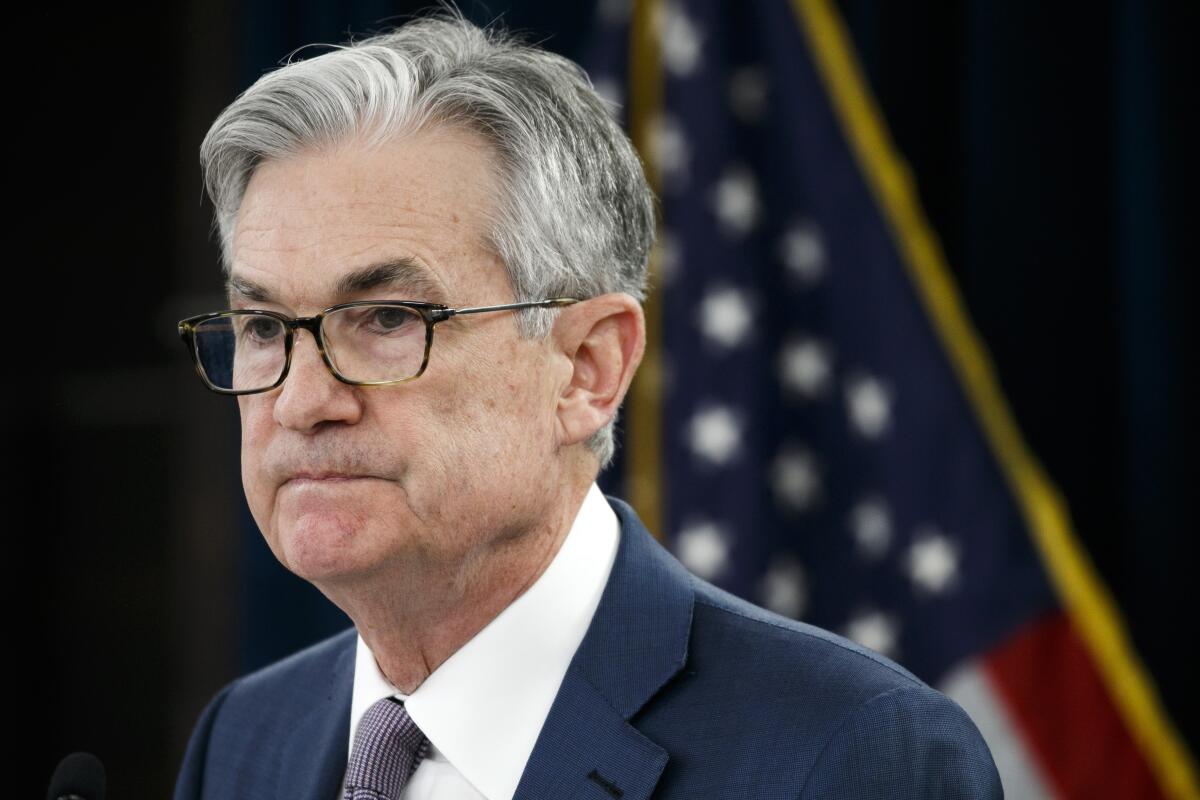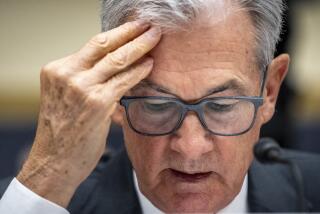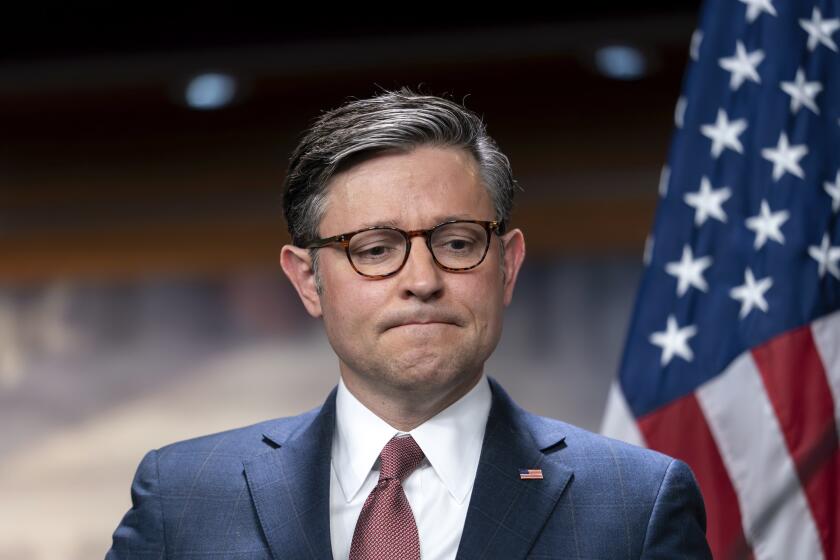Despite jobs rebound, Fed officials see long road to recovery from pandemic recession

- Share via
WASHINGTON — The Federal Reserve, in its first full-scale assessment of the U.S. economy as it moves through the COVID-19 pandemic, signaled Wednesday that it foresees a long and uncertain road to full recovery.
In economic projections released following a two-day meeting, the Fed indicated it was likely to hold interest rates near zero through at least 2022, which most economists said provided the clearest sign of what central bank policymakers see ahead.
“We’re not thinking about raising rates. We’re not even thinking about thinking about raising rates,” said Fed Chair Jerome H. Powell at a news conference.
In one optimistic note, the Fed departed from the predictions of most economists by saying the unemployment rate could fall fractionally below 10% by the end of 2020, to 9.3%.
The relatively bright unemployment forecast may partly reflect the unexpectedly good jobs report in May and partly the Fed’s desire to avoid a political brawl in a presidential election year.
“It’s a difficult time to be putting out a forecast…. This could be a real flashpoint,” said Diane Swonk, chief economist at Grant Thornton accounting firm in Chicago.
Beneath the fury over George Floyd’s death lie longstanding economic inequities that have plagued California’s 2.6 million black people.
Swonk said Powell has gone further than other Fed leaders and “way out of his comfort zone” in advocating for more fiscal relief, which Powell gently suggested again Wednesday. But, she added, “we’re already in fiscal fatigue, and the Fed’s been combating that.”
Even before the coronavirus struck, President Trump had repeatedly lambasted Powell for not doing enough to pump up the economy and thus Trump’s chances for reelection.
Some analysts noted that, in past economic crises, the Fed had often been overly optimistic about the pace of economic growth and inflation, which has been running persistently below the Fed’s 2% target.
“Chairman Powell and in effect most of the [Fed] committee seem very bearish and quite cautious about the outcome for the economy for the next two years,” said Lynn Reaser, chief economist at Point Loma Nazarene University in San Diego and a longtime Fed watcher.
The sobering Fed outlook “could take some steam out of those arguing for a V-shaped recovery,” said Christopher Rupkey, chief financial economist at MUFG Bank, referring to a relatively quick and complete bounce back from the downturn.
The Fed noted that the U.S. financial system was in relatively strong condition, thanks partly to the central bank’s aggressive actions to keep credit flowing. And policymakers predicted that the economy would make up considerable lost ground next year after shrinking at what will probably be a record pace in the second quarter.
But officials by and large do not expect the nation to get back to full employment — in which pretty much everyone who wants to work can find a job — until after 2022. Unemployment was at a 50-year low of 3.5% in February before the COVID-19 outbreak in the U.S.
The Fed projected the jobless rate to average 9.3% in the fourth quarter and decline to 6.5% in the final months of 2021, according to the median forecast from 17 Fed officials. The range of projections was wide, with some forecasting unemployment as low as 4.5% and as high as 12% in the fourth quarter of 2021.
The Congressional Budget Office, the nonpartisan budget and economic analysis arm of Congress, has been notably less optimistic than the Fed about the pace of recovery, especially on jobs. The CBO’s projections in May, before the better-than-expected jobs report, indicated unemployment was likely to average 8.6% at the end of 2021.
May numbers showed large job gains and a drop in the unemployment rate, to 13.3% from 14.7%, when many experts were expecting joblessness to rise to 20%.
Trump held up the May jobs report as evidence that the economy would soon be roaring back. But Powell noted that the report understated actual unemployment because of survey misclassifications. If those who dropped out of the labor force or were reduced to part-time work also were included, he said, the number of unemployed would be roughly 24 million people more than in February.
And in the weeks just ahead, the greatest effect of those numbers may be on critical policy decisions in Washington: whether or not to do more to speed a recovery and help businesses and unemployed workers survive in the meantime.
Most of the economic support programs Congress enacted when the pandemic first hit are running low on funds or will expire at the end of next month.
Some Republicans have taken the May jobs numbers as evidence that no more needs to be done. Democrats are pushing for another round of aid.
At his news conference Wednesday, Powell tried to avoid being pinned down on the aid question, though he did suggest further action would make a better, quicker recovery more likely.
“So bottom line, I would just say, the key thing people need to understand is that there is just a lot of work to do in the labor market,” Powell said. “And I think it may require Congress to help as well.”
As the pandemic struck and lockdowns designed to curb the virus hit the economy with tsunami-like force, the Fed has done everything at its disposal to stabilize financial markets.
Its statement Wednesday reaffirmed a pledge to maintain rock-bottom interest rates, keep offering large-scale government bond purchases and operate various lending programs for as long as needed.
Powell has previously indicated, however, that the central bank can only do so much and that more action from the White House and Congress was needed in light of the extraordinary economic toll from the health crisis.
Congress already has approved around $3 trillion in various pandemic relief measures.
In pushing for more fiscal support, Powell has been trying hard not to be drawn into the partisan maelstrom surrounding the pandemic and Washington’s response to it.
Recently, Trump has complimented Powell for responding swiftly and aggressively to the collapse in economic activity, but for most of the previous two years Trump and his supporters levied sharp attacks at Powell for a rate hike in late 2018 and not doing enough to prop up the economy.
More to Read
Inside the business of entertainment
The Wide Shot brings you news, analysis and insights on everything from streaming wars to production — and what it all means for the future.
You may occasionally receive promotional content from the Los Angeles Times.












